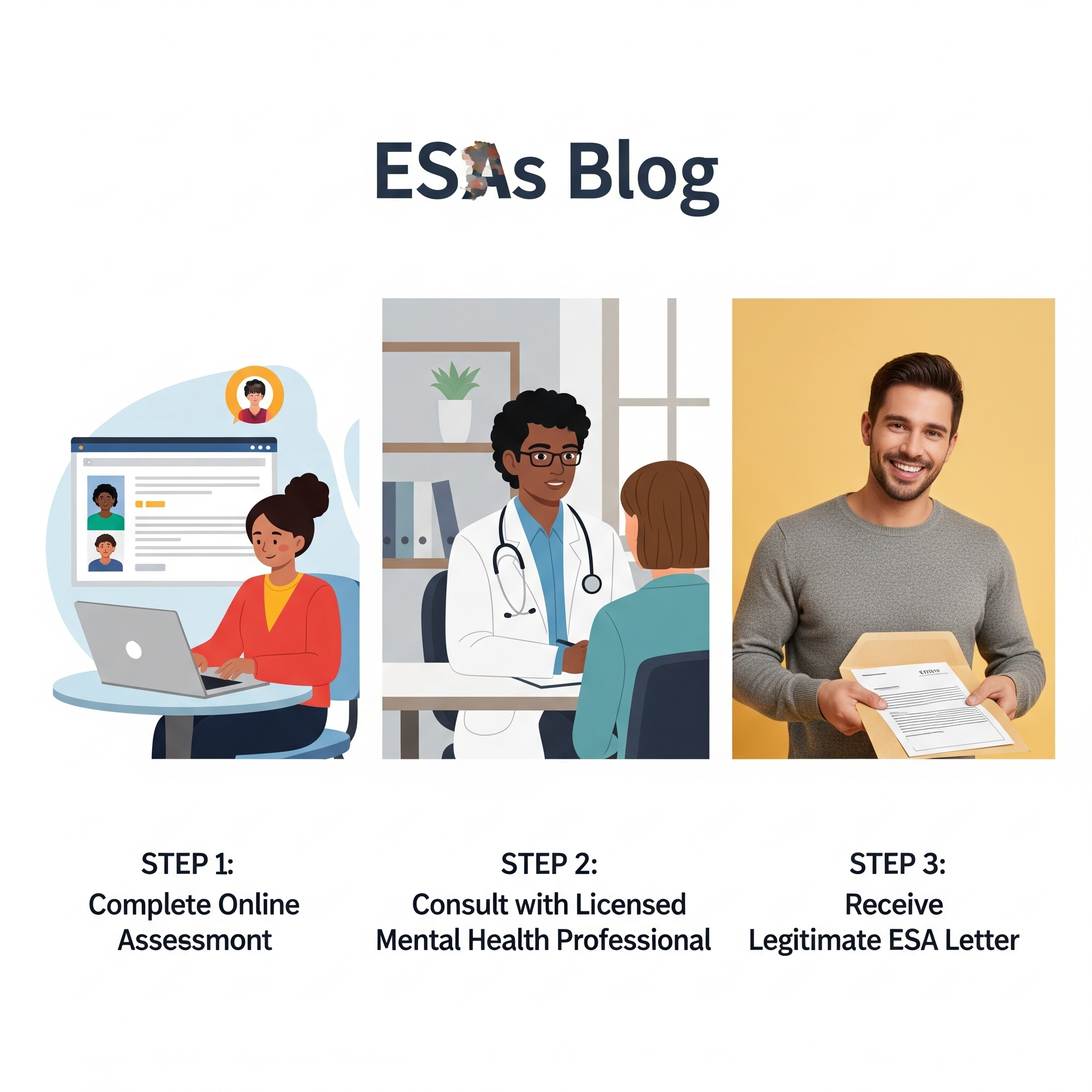For individuals living with psychiatric disabilities such as severe anxiety, depression, PTSD, or other mental health conditions, a Psychiatric Service Dog (PSD) is far more than a companion. These specially trained canines perform critical tasks that mitigate the challenges of their handler’s disability, enabling greater independence and participation in daily life. The Americans with Disabilities Act (ADA) stands as a cornerstone of protection for individuals with disabilities, ensuring their right to equal access and opportunity, including the right to be accompanied by their service animals in public spaces.
However, the nuances of the ADA, particularly concerning Psychiatric Service Dogs, are often misunderstood by both the public and handlers themselves. Misinformation can lead to stressful encounters and denial of access. At CertifyESA, we are dedicated to connecting individuals with licensed mental health professionals who can provide legitimate, APA-formatted documentation for their PSDs, ensuring they are empowered with accurate information about their rights. This comprehensive guide will demystify the ADA’s provisions for Psychiatric Service Dogs, clarifying what they are, what rights they afford, and what businesses and individuals need to know.
—
Defining a Service Animal Under the ADA: The Core Principles
The ADA is a federal civil rights law that prohibits discrimination against individuals with disabilities in all areas of public life, including jobs, schools, transportation, and all public and private places that are open to the general public. Under the ADA, a “service animal” has a very specific definition (Americans with Disabilities Act of 1990):
-
A Dog, Individually Trained: The ADA explicitly defines a service animal as any dog that has been individually trained to do work or perform tasks for the benefit of an individual with a disability. This means other species of animals, whether wild or domestic, trained or untrained, are not considered service animals under the ADA.
-
Work or Tasks Directly Related to the Disability: The crucial element is that the dog’s work or tasks must be directly related to the person’s disability. This is the fundamental distinction between a service animal and a pet or an emotional support animal (ESA).
-
Excluding Emotional Support: The ADA specifically states that the crime deterrent effects of an animal’s presence and the provision of emotional support, well-being, comfort, or companionship are not considered “work” or “tasks” under the definition of a service animal. While these benefits are invaluable, they do not, by themselves, qualify an animal as a service animal under the ADA (U.S. Department of Justice, n.d.-b).
This strict definition is important because it underpins the public access rights afforded to service animals, including Psychiatric Service Dogs.
—
Psychiatric Service Dogs (PSDs) Under the ADA: What Qualifies?
So, how does a Psychiatric Service Dog fit into this definition? A PSD is a type of service animal trained to perform specific tasks that mitigate a psychiatric disability. The key is the trained task, not just the dog’s presence or the comfort it provides.
Examples of tasks a PSD might be trained to perform include (U.S. Department of Justice, n.d.-b; Nolo, n.d.):
-
Interrupting Destructive Behaviors: Such as self-harm, repetitive behaviors, or anxiety attacks by nudging, pawing, or licking.
-
Providing Deep Pressure Therapy (DPT): Applying pressure to the handler’s lap or chest during panic attacks, anxiety attacks, or dissociative episodes to provide a grounding sensation.
-
Reminding to Take Medication: Alerting the handler at specific times to take prescribed medication.
-
Performing Room Checks/Perimeter Checks: Entering a room ahead of the handler to ensure no threats are present, which can be crucial for individuals with PTSD or severe anxiety.
-
Guiding Away from Overstimulating Environments: Leading a handler out of a crowded or overwhelming situation.
-
Blocking/Covering: Positioning themselves between the handler and others to create personal space or prevent unwanted approaches in crowded areas.
-
Retrieving Items: Fetching medication, a phone, or other necessary items during an episode.
-
Waking from Nightmares: For individuals with PTSD, a PSD can be trained to wake them from night terrors.
These are just a few examples; the tasks are highly individualized to the person’s specific disability and needs. The critical point is that the dog must be trained to do something specific to address the disability.
—
Public Access Rights: Where Can a PSD Go?
One of the most significant protections afforded by the ADA is the right of public access for service animals. Businesses and public accommodations must allow service animals to accompany their handlers in all areas where members of the public are generally allowed (U.S. Department of Justice, n.d.-a). This means:
-
No “No Pets” Policies: Businesses cannot deny entry to a legitimate PSD based on a “no pets” policy. A service animal is not a pet under the ADA.
-
No Segregation: A handler and their PSD cannot be segregated from other customers. For example, a restaurant cannot make them sit in a separate section.
-
No Extra Fees: Businesses cannot charge a surcharge or deposit for a service animal, even if they charge fees for pets. However, if a service animal causes damage, the handler can be charged for the damage, just like any other customer.
-
Wide Range of Locations: This right of access extends to virtually all public places, including restaurants, hotels, retail stores, theaters, hospitals (with some exceptions for sterile environments), public transportation, government offices, and schools.
—
What Businesses CAN and CANNOT Ask: The Two Permissible Questions
Businesses and public entities often feel uncertain about how to verify if an animal is a legitimate service animal. The ADA strictly limits the inquiries they can make. When it is not obvious that the dog is a service animal (e.g., a guide dog for a blind person), staff may only ask two specific questions (U.S. Department of Justice, n.d.-b):
-
“Is the dog a service animal required because of a disability?”
-
“What work or task has the dog been trained to perform?”
Staff CANNOT ask:
-
About the nature or extent of the person’s disability.
-
For any documentation for the dog, such as proof of certification, training, or licensing. There is no federal registry or certification for service animals.
-
That the dog demonstrate its task.
-
That the dog wear an identifying vest, tag, or special harness. While many handlers choose to use these for convenience, they are not legally required.
These limitations are in place to protect the privacy and dignity of individuals with disabilities.
—
When a PSD Can Be Excluded: Exceptions to Public Access
While public access rights are broad, there are limited circumstances under which a service animal can be legitimately excluded from a public place:
-
Out of Control: If the service animal is out of control and the handler does not take effective action to control it (e.g., repeated barking, lunging, jumping on people, not responding to commands).
-
Not Housebroken: If the service animal is not housebroken.
-
Direct Threat/Fundamental Alteration: If the presence of the service animal would fundamentally alter the nature of the goods, services, programs, or activities provided by the public entity. Examples might include a sterile operating room in a hospital or an area in a zoo where the service animal’s presence would disrupt the natural behavior of the exhibited animals (U.S. Department of Justice, n.d.-a).
In these cases, if the service animal is properly excluded, the individual with the disability must still be offered the opportunity to obtain goods or services without the animal.
—
Handler Responsibilities Under the ADA
With great rights come great responsibilities. Handlers of PSDs also have obligations under the ADA:
-
Control of the Animal: The service animal must be under the control of its handler at all times. This generally means the dog must be harnessed, leashed, or tethered, unless these devices interfere with the service animal’s work or the person’s disability prevents their use. In such cases, the handler must maintain control through voice commands, hand signals, or other effective means.
-
Care and Supervision: The handler is solely responsible for the care and supervision of the service animal, including toileting, feeding, grooming, and veterinary care. Businesses are not required to provide care or supervision for the animal.
-
Hygiene: The service animal must be housebroken.
—
PSDs vs. ESAs Under the ADA: A Critical Distinction
It is paramount to understand the distinction between Psychiatric Service Dogs and Emotional Support Animals (ESAs) under the ADA:
-
Psychiatric Service Dogs (PSDs): Are trained to perform specific tasks that mitigate a disability. They are recognized service animals under the ADA and have public access rights.
-
Emotional Support Animals (ESAs): Provide comfort simply by their presence and are not trained to perform specific tasks. They are not considered service animals under the ADA and therefore do not have the same public access rights. They are generally treated as pets in public accommodations (U.S. Department of Justice, n.d.-b).
While ESAs have crucial protections under the Fair Housing Act for housing accommodations, those protections do not extend to public access under the ADA. This distinction is a frequent source of confusion and highlights the importance of understanding the law.
—
The Role of a PSD Letter from a Licensed Mental Health Professional (LMHP)
While the ADA does not require any “certification” or “registration” for a PSD, a legitimate PSD letter from a Licensed Mental Health Professional (LMHP) is a crucial piece of documentation for several reasons:
-
Verification of Disability: The letter from an LMHP (obtained through services like CertifyESA) confirms that you have a diagnosed psychiatric disability and that your PSD is necessary to mitigate symptoms of this disability. While businesses cannot demand this letter, having it ensures that your foundational need for the PSD is professionally documented.
-
Housing Accommodations: A PSD letter from an LMHP is vital for housing providers under the Fair Housing Act, allowing your PSD to reside with you even in “no-pet” housing (Fair Housing Act, 1968).
-
Airline Travel: For air travel, while the U.S. DOT Service Animal Air Transportation Form is the primary requirement, the underlying need for a PSD stems from a disability that an LMHP can attest to.
-
Personal Confirmation and Confidence: Having a professionally prepared, APA-formatted letter from an LMHP provides a clear, defensible statement of your need for a PSD, which can be invaluable for your own peace of mind and for communicating with others (without disclosing your specific diagnosis).
At CertifyESA, we facilitate connections with licensed mental health professionals who can assess your eligibility for a PSD and provide the necessary documentation, empowering you with legitimate support.
—
Conclusion: Empowering Independence with Your PSD
The Americans with Disabilities Act serves as a powerful testament to the rights of individuals with disabilities, including those who rely on Psychiatric Service Dogs. By clearly defining what a service animal is, outlining public access rights, and limiting the inquiries that can be made, the ADA empowers handlers to navigate public spaces with confidence and independence.
Understanding these regulations is not just about avoiding conflict; it’s about advocating for your fundamental right to equal participation in society. With a legitimate Psychiatric Service Dog by your side, trained to perform tasks that mitigate your psychiatric disability, you are equipped to live a fuller, more integrated life.
CertifyESA is here to support you on this journey. By connecting you with qualified, licensed mental health professionals for legitimate, APA-formatted PSD letters, we help ensure that your need for a service animal is properly documented, allowing you to fully exercise your rights under the ADA and experience the profound benefits your Psychiatric Service Dog provides.
—
References
Americans with Disabilities Act of 1990, 42 U.S.C. § 12101 et seq. (1990).
Fair Housing Act, 42 U.S.C. § 3601 et seq. (1968).
U.S. Department of Justice. (n.d.-a). ADA Requirements: Service Animals. Retrieved from https://www.ada.gov/resources/service-animals-faqs/
U.S. Department of Justice. (n.d.-b). Frequently Asked Questions about Service Animals and the ADA. Retrieved from https://www.ada.gov/resources/service-animals-faqs/





